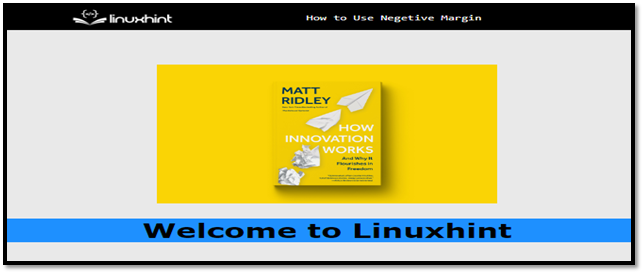This article demonstrates:
- How do Negative Margins in CSS Work?
- Using Negative Margin Top Property
- Using Negative Margin Bottom Property
- Using Negative Margin Right Property
- Using Negative Margin Left Property
- Why is margin-top: -5 != margin-bottom: 5?
How do Negative Margins in CSS Work?
The negative margin moves the content outside of the page. The method of using a negative margin is the same as the positive one, except the “-” is used with the value. Follow the below-mentioned variations of the negative margin:
Existing HTML File
The “book.jpg” is the image stored in the local directory its path is provided as the “src” value. The “width” and “height” of the image are set to 50%. Now create a “<div>” element and set its background to “dodgerblue”. Inside the “<div>” element create a “<h1>” tag and set its “color” to black:
<img src="../book.jpg" height="50%"; width="50%">
<div style="background-color: dodgerblue">
<h1 style="color: black;">Welcome to Linuxhint</h1>
</div>
</center>
After compiling the above code, the output looks like:
The “<h1>” tag is at the bottom of the webpage before applying a negative margin.
Using Negative Margin Top Property
Add “margin-top” property to the “<h1>” element and give its value in negative. For instance, here -15% is the value of the margin-top property:
<img src="../book.jpg" height="50%"; width="50%">
<div style="background-color:dodgerblue">
<h1 style="color: black; margin-top: -15%;">Welcome to Linuxhint</h1>
</div>
</center>
After executing the code, webpage look like this:
The output displays that the negative margin-top makes the “<h1>” element display in front of the parent element.
Using Negative Margin Bottom Property
Apply the same properties as above and just change the “margin-bottom” property. After that, add an image at the bottom of the “<div>” element to see visual changes:
<h3 style="color: black; margin-bottom: -5%;">Welcome to Linuxhint</h3>
</div>
<img src="../book.jpg" height="50%"; width="50%">
After updating code our webpage looks like this:
The above output shows that the text is getting the bottom margin of -5%.
Using Negative Margin Right Property
By giving -55% value of margin-right property to <h3> element, it moves in the opposite direction:
After executing the code output look like this:
The output shows that the text is getting the negative margin-right.
Using Negative Margin Left Property
The margin-left property having a negative value works in the same way. In the below code, the “<h3>” element moves 50% to the left side in the opposite direction to the margin-left property:
<h3 style="color: black; margin-left: -50%;">Welcome to Linuxhint</h3>
</div>
<img src="../book.jpg" height="50%"; width="50%">
The output of above code is:
That is how the negative margin works in CSS.
Why is margin-top:-5 != margin-bottom:5?
When the “margin-bottom:5%” is used it adds a margin from the bottom side towards the center of the element but when “margin-top:-5%” is used it adds a margin of 5% from the top but in the opposite direction(outside from the page).
Conclusion
In CSS, the negative margin works in the opposite direction by assigning the margin value. It moves the content of the element in the outward direction/outside of the page. The “margin-top:-5″ is not equal to “margin-bottom:5” because both property values move the content in opposite directions corresponding to the parent position. This article has successfully demonstrated how the negative margin works.





